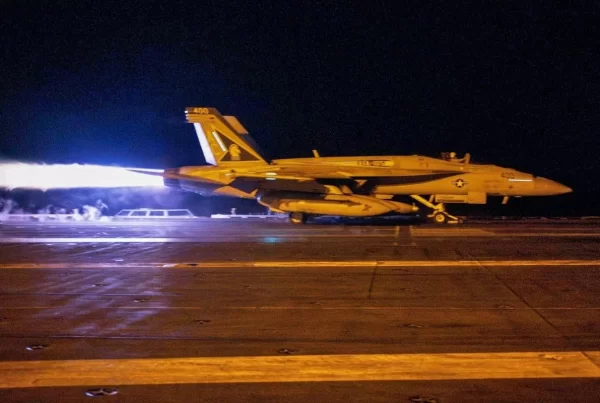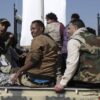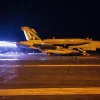THE UNITED STATES has come under increasing scrutiny for what seems like unconditional support for the Saudi Arabia-led coalition waging a brutal air war in Yemen. One of the key measures of that support has been refueling operations: U.S. tankers fill up planes from Saudi Arabia, the United Arab Emirates, and other coalition members, which go on to drop bombs in Yemen. Those bombs have killed at least 3,200 civilians and leveled hospitals and markets, leading to accusations that the U.S. is facilitating war crimes.
But U.S. Central Command, or CENTCOM, now admits that it doesn’t even know how much fuel it offloads for Saudi Arabia and its partners — directly contradicting information about refueling operations that it previously released. Responding to questions from The Intercept, CENTCOM now says that it lumps together refueling data for the coalition with data for U.S. planes in the area, joint U.S.-Emirati missions, and possibly other operations. Even this pooled data has unexplained discrepancies.
In other words: The U.S. military says it doesn’t know how much of its own fuel goes to an indefinite number of operations.
While refueling is just one way to track U.S. operations in Yemen, the muddling of missions for the fuel data reflects how haphazard and neglected U.S. policy in Yemen has become. Human rights groups and congressional staffers say that clear answers about what the U.S. is doing in Yemen are increasingly few and far between.
“Apparently this administration can’t get its story straight. There’s either blatant obfuscation, gross incompetence, or both going on.”
“Hill staff are asking basic questions about U.S. refueling support for the Saudi coalition in Yemen, and they haven’t gotten a straight answer from the administration,” said Kate Kizer, director of policy and advoacy at the Yemen Peace Project. “One agency says refueling is continuing, another says it stopped. Apparently this administration can’t get its story straight. There’s either blatant obfuscation, gross incompetence, or both going on.”
In June, The Intercept requested U.S. military figures for aerial refueling, and the response from CENTCOM indicated that refueling had reached record levels in 2017. In light of an escalation of U.S. and Emirati operations in southern Yemen — including several deadly raids and more than 80 reported U.S. airstrikes — The Intercept asked CENTCOM if some of the millions of pounds of fuel had gone toward missions other than the Saudi coalition’s. Absolutely not, they wrote back.
This was wrong, CENTCOM now acknowledges. A lot else about U.S. tracking of its refueling operations has proved unreliable or inaccurate. Not only do U.S. officials now say the totals include Emirati-U.S. operations, but they reference all refueling of any aircraft, including American ones, in a vaguely defined “Horn of Africa” area.
“The database [that tracks fueling] does not contain the specific details of each receiver (aircraft type, country of origin, mission type, or operations it was supporting),” said Lt. Col. Damien Pickart, spokesperson for U.S. Air Force Central Command.
For over two years, journalists had been able to obtain from the Air Force refueling totals for what was portrayed as the coalition. It wasn’t a perfect indication of U.S. support for the Saudi war against the Houthi rebels and allied forces in Yemen, who seized power in the capital and other regions in early 2015. But coupled with arms sales and local reports, it was a tangible measure of a hard-to-cover conflict, and it was regularly referenced by outlets including the Washington Post and the Air Force Times. It is now, on its face, of much less value.
“Theoretically, any mission being flown within a full tank of fuel is included in the total,” explained CENTCOM spokesperson Maj. Josh T. Jacques.
But the database itself appears flawed as well. Figures sent by Air Force Central Command — meant to be identical to previously released monthly totals, only now correctly labeled — now inexplicably differ by hundreds of thousands of pounds of fuel. For instance, The Intercept was originally told that the U.S. offloaded 4.039 million pounds of fuel to the Saudi coalition in March. This month, the Air Force gave a March figure of 3.452 million pounds “for ALL refueling operations conducted in the Horn of Africa, to include but not limited to Saudi-led operations in Yemen, U.S. missions in that area, and Emirate operations against [Al Qaeda in the Arabian Peninsula] targets.” How the admission of a wider net of operations could yield a smaller amount of fuel offloaded is unclear.
In Washington, congressional staffers are also trying to parse out the refueling program. Possibly due to confusion over what program the refueling is administered under, at least two congressional offices have been told this year that refueling for the Saudi-led coalition was stopped entirely.This is not the case, according to CENTCOM media chief Col. John Thomas.
“We do continue to supply fuel and training to them — we continue to refuel,” he told The Intercept this month. “It’s what they need when they need it.”
That definitive of a response was news to a staffer at one of the offices, who said that all aspects of U.S. support for the Saudi coalition campaign are opaque. (The staffer spoke to The Intercept anonymously to avoid identifying their boss.)
“We are still struggling to find out basic things like, do we have people at the Saudi air command center, what are they doing, what access do they have, what ability do they have to influence events,” said the staffer. “How are the Saudis actually abiding by the non-strike list, are they still refueling — those are all things we have no idea about, and the administration isn’t exactly forthcoming about it.”

Yemenis check the site of an air raid that hit a funeral reception in the Arhab district, 40 kilometres (25 miles) north of the capital Sanaa, on February 16, 2017. / AFP / MOHAMMED HUWAIS (Photo credit should read MOHAMMED HUWAIS/AFP/Getty Images)
OUTSIDE OF THE Saudi coalition support and any secret activities, the United States was already engaged in a long-standing and deadly drone campaign against Al Qaeda in the Arabian Peninsula (AQAP) and now conducts bilateral counterterror activities with the UAE. The practical and legal distinctions between these operations are important, but increasingly blurred. Military spokespeople have at times tended to merge all the facets of U.S. involvement in Yemen, and the press often follows suit.
“U.S. refueling of Saudi and Emirati planes may be regarded by some as merely a logistical detail, whereas it is important component of these countries’ bombing campaigns in Yemen,” said Alex Moorehead, counterterrorism director at Columbia Law School’s Armed Conflict and Human Rights Project. “If the U.S. military is uncertain of its data, how does it ensure it is not complicit in alleged violations by the Saudi-led coalition, and how does it track what operations it is supporting, against whom and to what degree?”
Since March 2015, the United Nations has documented at least 5,144 civilian deaths from the conflict in Yemen. That total is widely considered a vast undercount, but the number of those civilians killed by the Saudi coalition — 3,233, or 62.8 percent, as of September — has remained more or less proportionally consistent.
In July, a U.N. panel of experts cited the coalition for obfuscating the role of individual members — a similar charge has been levied against the U.S.-led anti-ISIS coalition in Iraq and Syria.
“Some individual member states of the Saudi-Arabia-led coalition seek to hide behind ‘the entity’ of the coalition to shield themselves from state responsibility for violations committed by their forces,” said the panel in a report to the Security Council first reported by Reuters and obtained by The Intercept. The panel cited an as-of-now unacknowledged Red Sea helicopter attack on a boat filled with Somali refugees that left more than 40 dead. “The Saudi Arabia-led coalition forces are the only parties to the conflict that have the capability to operate armed utility helicopters in the area,” concluded the panel.
Groups, including Human Rights Watch, consider the United States a party to the civil war in Yemen, even if neither the Obama or Trump administrations have accepted that position. With the exception of a letter sent after a retaliatory strike on Houthi radar installations last October, Barack Obama and Donald Trump have both only kept Congress informed of ongoing counter-AQAP operations.
“Refueling coalition planes on bombing missions not only makes the U.S. a party to the Yemen conflict, but could also lead to U.S. personnel being found complicit in coalition war crimes,” said Kristine Beckerle, Yemen and UAE researcher at Human Rights Watch. “It turns out the U.S. military, which is backing the very same coalition that has bombed homes, schools, and hospitals, is not even tracking which coalition planes it is refueling, or the missions they are undertaking. The Pentagon should not only be tracking this information, it should be disclosing it to the public, who has the right to know whether U.S. assistance is contributing to war crimes.”
“The Pentagon should not only be tracking this information, it should be disclosing it to the public, who have the right to know whether U.S. assistance is contributing to war crimes.”
There is little sense that the Trump administration will push for changes to the way the coalition operates. While the Obama White House initiated U.S. support for the Saudi bombing campaign, it also put some pressure on Saudi Arabia — behind the scenes — to cut down on civilian casualties. Critics said this was meaningless if not done publicly and pointed to the fact that Obama only cut off the sale of precision-guided munitions after Trump had been elected — and after he had approved already record arms sales to Riyadh and the Gulf. Trump has overturned that ban.
“The Saudis are less worried about their relationship with the U.S. with Trump in power,” said Farea Al-Muslimi, a scholar at the Carnegie Middle East Center. “There is already this understanding that the Saudis and Americans are in a king-size bed, compared to with Obama, when they were sharing a couch.”
WITH THE SPOTLIGHT ON SAUDI ARABIA, the role of the UAE has come under less scrutiny across both administrations. The Pentagon considers the Emiratis more militarily competent than the Saudis, and some analysts say the UAE is making progress in reducing Al Qaeda’s presence in Yemen.
On August 3, the UAE announced a joint operation with the United States in Shabwah Governorate, the site of American drone strikes under Trump. The next day, officials at the Pentagon told reporters that a “small number of U.S. forces” were on the ground to facilitate information-sharing with the UAE. The United States was providing aerial reconnaissance and, they said, aerial refueling for the UAE.
But what exactly has been accomplished by the joint U.S.-Emirati Shabwah offensive against AQAP remains elusive. In previous battles, such as during the capture of Mukalla in April 2016, AQAP militants melted away without much fighting; last week, UAE-backed forces captured Al Wade’a in Abyan province from the militants, but again, Al Qaeda forces reportedly withdrew rather than offer much of a fight.
“It’s really murky what’s happening in the south,” said one western analyst of Yemen, who didn’t want to give their name due to fears that the UAE would ban them from travel in the country. “The UAE operation as announced was a huge thing, then suddenly it was very quickly dropped. The whole thing bordered on nonsensical to be honest — it was theater.”
The UAE, Saudi Arabia, and United States also have to reckon with the uncomfortable reality that extremist elements, including AQAP, have been useful in battles against the coalition’s main foe, the Houthis. In some cases that means supporting local commanders who in turn support AQAP, as happened in the heavily contested city of Taiz. The U.N. Panel of Experts for Yemen documented “direct financial and material support from the UAE” for the Salafi commander Shaykh Abu al-Abbas, who “allowed the spread of AQAP elements within the city as a force multiplier.”
The UAE has also been documented running a network of secret prisons in Yemen, where hundreds have disappeared and detainees are reportedly tortured. Elsewhere in the country it has run operations along the Red Sea coast, with the use of Sudanese soldiers and an ultimate goal of taking Yemen’s largest port of Hodeidah. Such a fight could further cut off supplies to famished Yemenis — 18.8 million of whom who are in need of humanitarian assistance, including 7.3 million described by the U.N. as “on the brink of famine.” A cholera outbreak abetted by the humanitarian crisis has reached historic proportions, infecting more than 600,000 and leaving nearly 2,000 dead.
In an upcoming paper, William Hartung, director of the Arms & Security Project at the Center for International Policy, argues that, despite the focus on Saudi Arabia, “as the primary source of arms and training for the UAE military, the United States bears some responsibility for that country’s actions in Yemen.”






